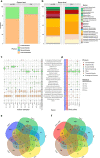The sanitary indoor environment-a potential source for intact human-associated anaerobes
- PMID: 35650275
- PMCID: PMC9160270
- DOI: 10.1038/s41522-022-00305-z
The sanitary indoor environment-a potential source for intact human-associated anaerobes
Abstract
A healthy human microbiome relies on the interaction with and exchange of microbes that takes place between the human body and its environment. People in high-income countries spend most of their time indoors and for this reason, the built environment (BE) might represent a potent source of commensal microbes. Anaerobic microbes are of particular interest, as researchers have not yet sufficiently clarified how the human microbiome acquires oxygen-sensitive microbes. We sampled the bathrooms in ten households and used propidium monoazide (PMA) to assess the viability of the collected prokaryotes. We compared the microbiome profiles based on 16S rRNA gene sequencing and confirmed our results by genetic and cultivation-based analyses. Quantitative and qualitative analysis revealed that most of the microbial taxa in the BE samples are human-associated. Less than 25% of the prokaryotic signatures originate from intact cells, indicating that aerobic and stress resistant taxa display an apparent survival advantage. However, we also confirmed the presence of intact, strictly anaerobic taxa on bathroom floors, including methanogenic archaea. As methanogens are regarded as highly sensitive to aerobic conditions, oxygen-tolerance experiments were performed with human-associated isolates to validate their survival. These results show that human-associated methanogens can survive oxic conditions for at least 6 h. We collected strong evidence that supports the hypothesis that obligate anaerobic taxa can survive in the BE for a limited amount of time. This suggests that the BE serves as a potential source of anaerobic human commensals.
© 2022. The Author(s).
Conflict of interest statement
The authors declare no competing interests.
Figures






References
Publication types
MeSH terms
Substances
Grants and funding
LinkOut - more resources
Full Text Sources
Molecular Biology Databases
Research Materials

